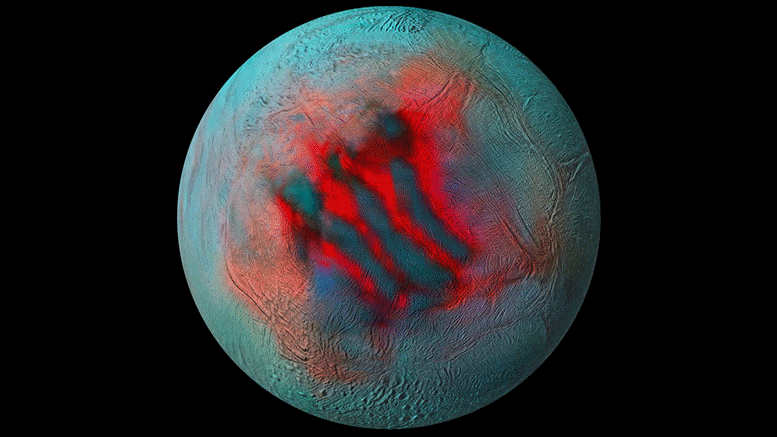
في هذه الصور التفصيلية بالأشعة تحت الحمراء لقمر زحل الجليدي إنسيلادوس ، تمثل المناطق الحمراء جليدًا جديدًا على السطح. الائتمان: NASA / JPL-Caltech / جامعة أريزونا / LPG / CNRS / جامعة نانت / معهد علوم الفضاء.
البحر الجوفي[{” attribute=””>Saturn’s moon is most likely rich in phosphorus, a key component for life.
The hunt for extraterrestrial life has just become more intriguing as a group of researchers led by Dr. Christopher Glein of the Southwest Research Institute found new evidence of a key building block for life in the subsurface ocean of Saturn’s moon Enceladus. According to new modeling, Enceladus’ ocean should be quite rich in dissolved phosphorus, a crucial ingredient for life.
“Enceladus is one of the prime targets in humanity’s search for life in our solar system,” said Glein, a leading expert in extraterrestrial oceanography. He is a co-author of a paper recently published in the journal Proceedings of the National Academy of Sciences (PNAS) describing this research. “In the years since NASA’s Cassini spacecraft visited the Saturn system, we have been repeatedly blown away by the discoveries made possible by the collected data.”

SwRI Lead Scientist Dr. Christopher Glein contributed to new findings that phosphorus in the form of orthophosphate (e.g., HPO4-2) is likely abundant in the subsurface ocean of Saturn’s moon Enceladus. A soda or alkaline ocean (containing NaHCO3 and/or Na2CO3) inside of Enceladus interacts geochemically with a rocky core. Modeling indicates that this interaction promotes the dissolution of phosphate minerals, making orthophosphate readily available to possible life in the ocean. Because phosphorus is an essential ingredient for life, this finding bolsters mounting evidence for habitability within this small Saturnian moon. Credit: Southwest Research Institute
The Cassini mission detected and analyzed samples of Enceladus’ underlying liquid water when plumes of ice grains and water vapor burst into space from cracks in the moon’s icy surface.
“What we have learned is that the plume contains almost all the basic requirements of life as we know it,” Glein said. “While the bioessential element phosphorus has yet to be identified directly, our team discovered evidence for its availability in the ocean beneath the moon’s icy crust.”
One of the most significant findings in planetary science in the last 25 years is that worlds with oceans under an ice surface layer are common in our solar system. The icy satellites of the large planets, including Europa, Titan, and Enceladus, as well as more distant entities like Pluto, are examples of such worlds. Worlds with surface seas, like Earth, must stay within a narrow range of distances from their host stars in order to maintain temperatures suitable for surface liquid water. Interior water ocean worlds, on the other hand, may occur across far greater distances, substantially increasing the number of habitable worlds that are predicted to exist throughout the galaxy.
“The quest for extraterrestrial habitability in the solar system has shifted focus, as we now look for the building blocks for life, including organic molecules, ammonia, sulfur-bearing compounds as well as the chemical energy needed to support life,” Glein said. “Phosphorus presents an interesting case because previous work suggested that it might be scarce in the ocean of Enceladus, which would dim the prospects for life.”
Phosphorus in the form of phosphates is vital for all life on Earth. It is essential for the creation of DNA and RNA, energy-carrying molecules, cell membranes, bones, and teeth in people and animals, and even the sea’s microbiome of plankton.
Team members performed thermodynamic and kinetic modeling that simulates the geochemistry of phosphorus based on insights from Cassini about the ocean-seafloor system on Enceladus. In the course of their research, they developed the most detailed geochemical model to date of how seafloor minerals dissolve into Enceladus’s ocean and predicted that phosphate minerals would be unusually soluble there.
“The underlying geochemistry has an elegant simplicity that makes the presence of dissolved phosphorus inevitable, reaching levels close to or even higher than those in modern Earth seawater,” Glein said. “What this means for astrobiology is that we can be more confident than before that the ocean of Enceladus is habitable.”
According to Glein, the next step is clear: “We need to get back to Enceladus to see if a habitable ocean is actually inhabited.”
Reference: “Abundant phosphorus expected for possible life in Enceladus’s ocean” by Jihua Hao, Christopher R. Glein, Fang Huang, Nathan Yee, David C. Catling, Frank Postberg, Jon K. Hillier and Robert M. Hazen, 19 September 2022, Proceedings of the National Academy of Sciences.
DOI: 10.1073/pnas.2201388119

“متعصب التلفزيون. مدمن الويب. مبشر السفر. رجل أعمال متمني. مستكشف هواة. كاتب.”






More Stories
خريطة جديدة للمريخ تكشف عن “هياكل” مخفية تحت سطح المريخ
زوج من نفاثات البلازما الضخمة تندلع من ثقب أسود هائل | الثقوب السوداء
الأسمنت المستوحى من عظام الإنسان أصعب بخمس مرات من الخرسانة العادية